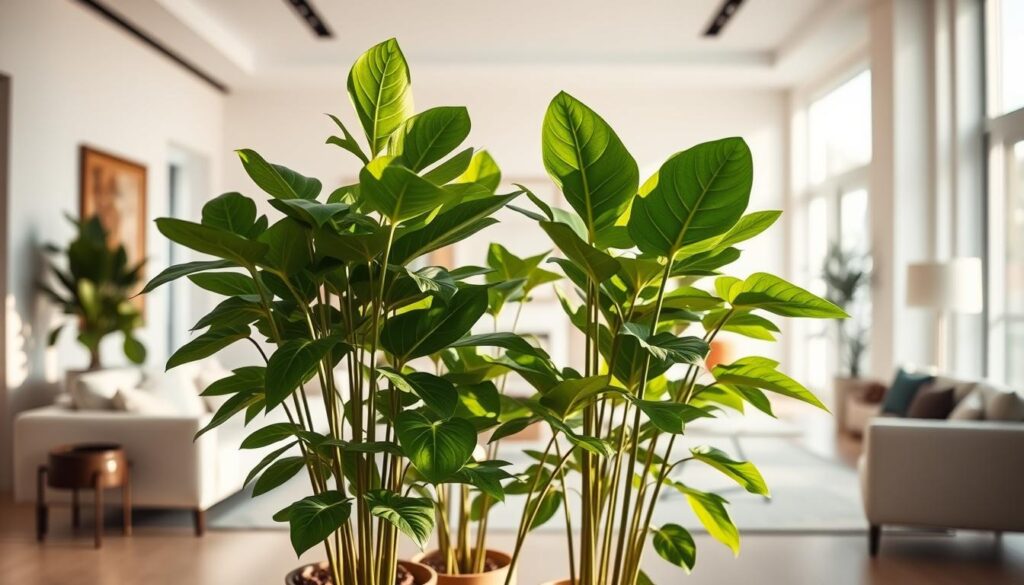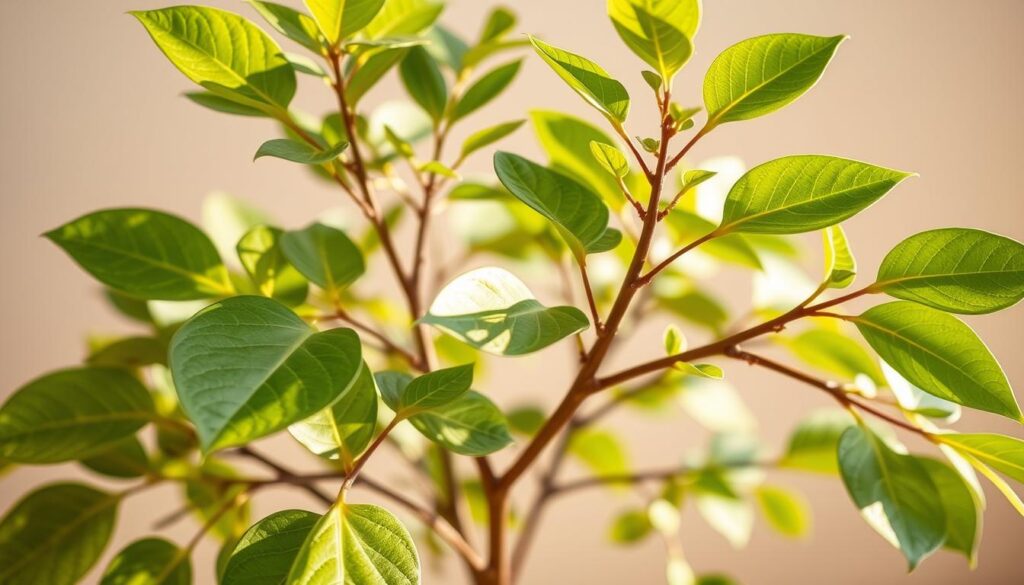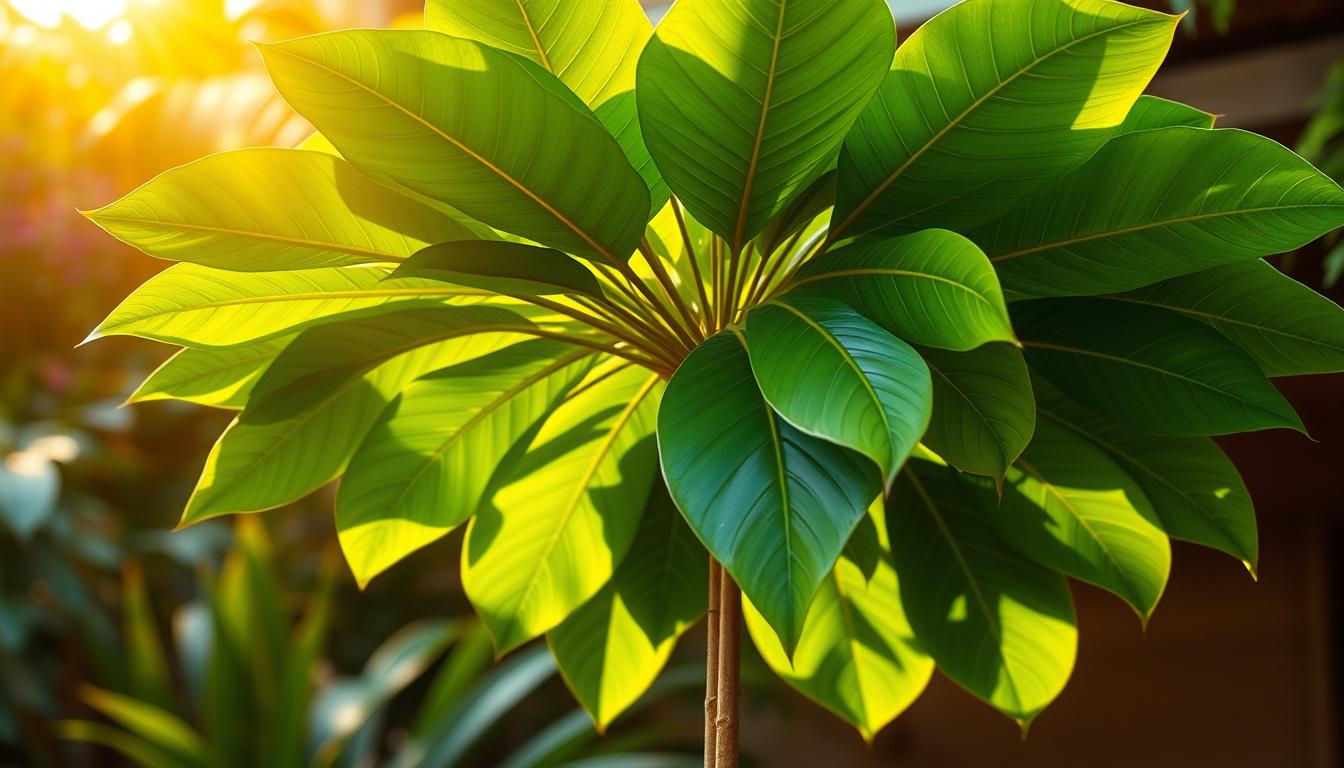Picture stepping into a room and being greeted by the lush, vibrant presence of an umbrella plant. It turns your living space into a tropical paradise. The schefflera plant is more than just a houseplant. It’s a piece of living art that adds life, color, and amazing benefits to your home.
Whether you’re a plant expert or just starting, the umbrella plant has something for everyone. Its unique umbrella-like leaves and stunning green color make it a standout. It’s not just about looks; it also purifies the air and adds beauty to your space.
In this guide, you’ll learn about seven incredible benefits of the schefflera plant. It’s a tropical treasure that’s more than just beautiful. It’s a must-have for your home.
Table of Contents
Understanding the Umbrella Plant’s Natural Habitat
Schefflera plants are a group of tropical foliage loved by many. They come from Asia, Africa, and the Pacific. They add exotic beauty to any home.
The Schefflera genus has about 600 species. Two, Schefflera actinophylla and Schefflera arboricola, are favorites for indoor plants. They are great for making your home look better.
Native Regions and Growing Conditions
Schefflera plants love humid, warm places. They need sunlight filtered by trees and rich soil. These conditions help them thrive.
- High humidity levels
- Warm temperatures between 60-80°F
- Filtered sunlight through forest canopies
- Rich, well-draining soil conditions
Natural Growth Patterns in the Wild
In the wild, Schefflera plants grow as understory trees or shrubs. They have big, umbrella-like leaves. These leaves help them catch sunlight in dense forests.
Adaptability to Indoor Environments
Schefflera plants are very adaptable to indoor spaces. With the right care, they can thrive in your home. This makes them perfect for indoor plants.
| Native Region | Typical Climate | Growth Characteristics |
|---|---|---|
| Southeast Asia | Tropical rainforest | Large, compound leaves |
| Pacific Islands | Humid subtropical | Compact growth |
| Northern Australia | Warm tropical | Robust root systems |
Knowing where Schefflera plants come from helps you create the best home for them. This ensures they stay healthy and vibrant.
The Beauty and Appeal of the Schefflera Plant
Looking for a stunning indoor plant? The arboricola is a top choice. It brings life and elegance to your space. Its leaf clusters, shaped like umbrellas, create a striking visual impression.
The dwarf schefflera has two main types that gardeners love:
- Schefflera actinophylla features large, oval leaves that can grow up to 10 inches long, radiating from a central stalk.
- Schefflera arboricola: A smaller version with leaves 1-2 inches long in tight clusters
The plants’ glossy, vibrant foliage is what makes them special. Their leaves have intricate patterns and rich green colors. Variegated types add more interest with creamy blotches and unique colors.
The arboricola’s architectural form is a big plus for your interior design. It fits well in modern or bohemian rooms. Its structured growth adds a natural sculpture to your home’s look.
Nature’s artistry comes alive with the dwarf schefflera’s captivating leaf structures and vibrant green palette.
Essential Growing Requirements for Success
To care for a Schefflera plant, you need to know its specific needs. This tropical beauty is great for indoor spaces with the right care.
For your Schefflera to grow well, you must create the best growing conditions. This means making its environment similar to its natural home. Let’s look at what your Schefflera needs to thrive.
Light Requirements for Optimal Growth
Your Schefflera loves bright, indirect light but also does well in low light. While it can handle less light, it might:
- Grow slower
- Look leggy or stretched
- Have fewer leaves
Temperature and Humidity Sweet Spot
Keeping your Schefflera warm is key to its health. The right temperature range helps it grow strong and avoid stress.
| Temperature Range | Plant Response |
|---|---|
| 60-75°F | Optimal Growing Conditions |
| Below 50°F | Potential Growth Stunting |
Soil and Watering Techniques
Choosing the right soil is crucial for your Schefflera’s health. Pick a mix that drains well and gives your plant the nutrients it needs.
Watering is a careful process. Let the top inch of soil dry out before watering again. This prevents root rot and promotes overall plant health.
- Water thoroughly when the soil feels dry
- Ensure proper drainage
- Reduce watering in winter
By following these care tips, you’ll make a great home for your Schefflera. It will become a beautiful part of your indoor space.
Air Purifying Properties and Health Benefits

Schefflera plants are top-notch air purifiers that can change your home’s air. They are not just pretty; they also clean the air you breathe.
Indoor air can have pollutants from things like furniture, cleaners, and gadgets. Schefflera plants act as natural filters. They filter out toxins and improve the air quality in your home.
- Removes formaldehyde from household materials
- Filters the benzene released by paint and glue
- Reduces xylene found in printing and rubber products
Studies back up Schefflera’s amazing air-cleaning skills. According to NASA research, they can significantly reduce indoor air pollutants and improve air quality. This makes them key for anyone who cares about health.
These plants offer more benefits than simply purifying the air. They also:
- Reduce stress levels
- Increase humidity
- Boost mental well-being
Breathe easier and live healthier with a Schefflera plant in your living space.
Popular Schefflera Varieties for Your Home
The Schefflera actinophylla, commonly known as the umbrella plant, is a striking choice for indoor spaces. It has:
The Schefflera plant world is full of choices. There’s something for everyone, whether you have a big or small space. Let’s look at the top picks to brighten your home.
Schefflera Actinophylla: The Classic Umbrella Plant
The Schefflera actinophylla, or umbrella plant, is a standout indoor plant. It has:
- Oval leaves up to 10 inches long
- Can grow up to 15 feet tall indoors
- A striking central stalk
Dwarf Schefflera Arboricola: Perfect for Compact Spaces
For a smaller Schefflera, the dwarf Schefflera arboricola is great. It has:
- Smaller leaves, 1-2 inches
- Tight leaf clusters
- Great for small spaces or tables
Variegated Schefflera: Adding Visual Interest
Variegated Schefflera plants add color to your garden. They have:
- Creamy spots on green leaves
- More visual interest
- Need special care to keep colors bright
| Variety | Leaf Size | Height Potential | Best Location |
|---|---|---|---|
| Schefflera Actinophylla | Up to 10 inches | 15 feet indoors | Large, open spaces |
| Dwarf Schefflera Arboricola | 1-2 inches | 3-5 feet | Tabletops, small rooms |
| Variegated Schefflera | 2-4 inches | 6-8 feet | Bright, indirect light areas |
Pro tip: Pick your schefflera based on your space, light, and style.
Maintenance and Pruning Tips

Learning to care for your Schefflera is key. These plants thrive with the right care. They stay healthy and bright.
Pruning your Umbrella plant is easy and makes a big difference. Prune in spring and summer when the plant is growing. This helps it grow back strong and fast.
- Use clean, sharp pruning shears to avoid damaging the plant.
- Make cuts just above the leaf nodes to promote bushier growth.
- Remove dead, yellowing, or damaged leaves regularly
- Trim back elongated stems to maintain a more compact shape.
To keep your Schefflera in top shape, focus on the right environment. Gentle pruning encourages the growth of new branches and helps the plant stay full and attractive. Wear gloves and cut at a 45-degree angle for healing.
Don’t forget to rotate your Schefflera. This ensures it grows evenly and doesn’t lean towards light. It keeps your plant looking balanced and beautiful.
Pro Tip: Always prune during the plant’s active growth period for best results!
Schefflera plants are easy to care for and can look great all year. With a little effort, your plant will stay stunning.
Common Problems and Solutions
Caring for indoor plants can sometimes present challenges, and Schefflera is no exception. Understanding potential issues in houseplant care will help you maintain a healthy and thriving indoor plant.
Pest Management Strategies
Your Schefflera can attract several common indoor plant pests. Identifying and addressing these quickly is crucial for maintaining plant health.
- Aphids: Check for small insects gathering on the stems and leaves.
- Mealybugs: White, cotton-like clusters indicate their presence
- Spider mites: Tiny web-like structures between leaves signal an infestation
For effective pest control, use insecticidal soap spray or neem oil. Regularly inspect your indoor plants to catch potential problems early.
Disease Prevention and Treatment
Preventing diseases in indoor plants requires understanding their root causes. Overwatering is a primary culprit for many Schefflera health issues.
- Avoid waterlogged soil
- Ensure proper drainage
- Use well-draining potting mix
Troubleshooting Growth Issues
Some common growth problems in Schefflera include leaf drop, yellowing leaves, and stunted growth. These often stem from environmental stress or improper care.
- Leaf drop: Typically signals temperature changes or inadequate light.
- Yellowing leaves: Potential signs of overwatering or nutrient deficiencies
- Stunted growth: May result from inadequate fertilization or root-bound conditions
By understanding these potential challenges in indoor plants, you can proactively manage your Schefflera’s health and enjoy a vibrant, thriving houseplant.
Propagation Methods and Techniques
Want to grow more umbrella plants? It’s simpler than you think. You can make new plants from an old one. Spring is the best time to do this, when the plant is growing fast.
Stem cuttings are the top way to grow your umbrella plant. Pick a stem that’s green and healthy, with no damage.
- Choose a stem about 6 inches long
- Use sharp, clean pruning shears
- Cut the stem at a 45-degree angle
- Remove lower leaves, keeping 4-5 leaves at the top
There are two main ways to grow your Schefflera plant:
- Water Propagation: Put the cutting in a clear glass of water, making sure leaves stay above the water
- Soil Propagation: Coat the cut end with rooting hormone and place it in a well-draining potting mix.
It takes 4-6 weeks for roots to grow. Keep the area warm and lightly lit. Soon, your new plant will have strong roots, ready for its new home.
Decorative Uses and Styling Ideas
Make your living spaces pop with Schefflera plants. These indoor plants are versatile and stunning. They can enhance any room, making it look better and feel more natural.
Schefflera plants add charm to your home with their unique leaves. They fit well in many design styles. This makes them ideal for various rooms in your home.
Room Placement Suggestions
Choosing the right spot for your Schefflera can make it stand out. Here are some great places to put it:
- Living room corners with indirect light
- Home office spaces near windows
- Bedroom accent areas with moderate humidity
- Entryways with filtered sunlight
Design Combinations with Other Plants
Pair Schefflera with other plants for amazing indoor arrangements. They pair well with:
| Companion Plant | Complementary Design Style |
|---|---|
| Snake Plant | Modern Minimalist |
| Pothos | Tropical Bohemian |
| Monstera | Lush Green Sanctuary |
When styling your Schefflera, try different pot colors and textures. Play with heights to add interest. Your Schefflera can be the star of any room.
Safety Considerations for Homes with Pets
If you have pets and want to add schefflera plants to your home, be careful. All parts of the Schefflera plant have calcium oxalate crystals. These can be harmful to dogs and cats if they eat them.
Keeping your pets safe around these plants is important. These plants can cause health problems, including:
- Severe mouth and throat irritation
- Excessive drooling
- Difficulty swallowing
- Potential swelling of the tongue and throat
To keep your pets safe, try these tips:
- Use hanging planters out of pet reach
- Position Schefflera in rooms inaccessible to pets
- Create barriers using shelving or plant stands
If your pet accidentally ingests Schefflera, contact your veterinarian immediately. Symptoms can show up fast. Getting help from a vet is key to avoiding serious issues.
If your pet accidentally consumes Schefflera, contact your veterinarian right away. Symptoms can show up fast. Getting help from a vet is key to avoiding serious issues.
Conclusion
The Schefflera plant is a great choice for anyone who loves indoor plants. It’s easy to care for and can make your home look better. It also helps clean the air and fits well in different lighting conditions.
These plants are not just pretty. They can make your home feel fresher and healthier. With the right care, they can live for over 15 years. This makes them a smart choice for your home’s decor.
Learning how to care for a schefflera plant is easy. It can help improve the air you breathe and make your home look nicer. It’s a great way to bring nature indoors and make your home feel more alive.
Starting a schefflera plant in your home can be very rewarding. It adds beauty and function to your space. It’s a great way to connect with nature and make your home a happier place.
FAQ
How often should I water my Schefflera plant?
Water your Schefflera once the top 1–2 inches of soil feel dry to the touch. This usually means watering every 7-10 days. But it can change based on humidity, temperature, and light. Ensure the soil drains properly and avoid letting it become waterlogged.
Can Schefflera plants survive in low light conditions?
Yes, Schefflera plants can handle low to medium light. They thrive in bright, indirect light but can also tolerate lower light conditions. However, in very dim light, they might grow leggy and produce fewer leaves.
Are Schefflera plants toxic to pets?
Schefflera plants are toxic to cats and dogs. They contain calcium oxalate crystals that can irritate mouths, cause drooling, and upset stomachs if eaten. Keep them away from pets and kids to avoid accidents.
How do I propagate a Schefflera plant?
You can propagate Schefflera through stem cuttings. Take a 4–6 inch cutting with leaves, remove the lower leaves, and place it in water or soil. Keep it warm and humid until roots grow, which should take 4-6 weeks.
What are the best varieties of Schefflera for indoor growing?
The best varieties for indoors are Schefflera actinophylla (larger umbrella plant) and Schefflera arboricola (dwarf schefflera). The dwarf variety is great for indoor spaces because it grows smaller and is easier to care for.
How do I treat common pests on my Schefflera?
To treat pests like spider mites, mealybugs, and scale, wipe leaves with mild soap or use neem oil or insecticidal soap. Check your plant often and keep it separate from other plants if you see pests.
Can I place my Schefflera in a bathroom?
Yes, Schefflera plants love the humidity of bathrooms. Just make sure the bathroom has enough indirect light and isn’t too cold. The humid environment is good for these tropical plants.
How often should I fertilize my Schefflera?
Feed your Schefflera monthly in spring and summer using a balanced fertilizer. Stop or reduce fertilizing in fall and winter when the plant grows less.
Why are the leaves of my Schefflera turning yellow?
Yellow leaves can mean overwatering, poor drainage, insufficient light, or lack of nutrients. Check your watering, ensure good drainage, and provide enough indirect light to keep your plant healthy.
How tall can a Schefflera plant grow indoors?
Indoor Schefflera plants can reach heights of 4 to 8 feet, depending on the variety and how well they are cared for. The dwarf Schefflera (arboricola) is smaller, while the larger variety (actinophylla) can grow tall if not pruned.

